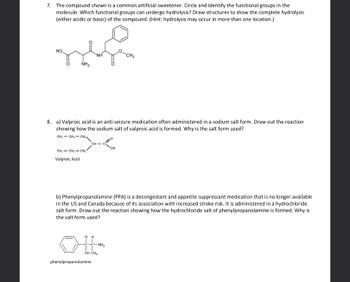
Chemistry
10th Edition
ISBN: 9781305957404
Author: Steven S. Zumdahl, Susan A. Zumdahl, Donald J. DeCoste
Publisher: Cengage Learning
expand_more
expand_more
format_list_bulleted
Concept explainers
Question
Please answer #7 and 8

Transcribed Image Text:7. The compound shown is a common artificial sweetener. Circle and identify the functional groups in the
molecule. Which functional groups can undergo hydrolysis? Draw structures to show the complete hydrolysis
(either acidic or basic) of the compound. (Hint: hydrolysis may occur in more than one location.)
HO
NH₂
CH₁ CH₂ - CH₂
Valproic Acid
8. a) Valproic acid is an anti-seizure medication often administered in a sodium salt form. Draw out the reaction
showing how the sodium salt of valproic acid is formed. Why is the salt form used?
CH3CH₂CH₂
ΝΗ
CH C
HH
phenylpropanolamine
b) Phenylpropanolamine (PPA) is a decongestant and appetite suppressant medication that is no longer available
in the US and Canada because of its association with increased stroke risk. It is administered in a hydrochloride
salt form. Draw out the reaction showing how the hydrochloride salt of phenylpropanolamine is formed. Why is
the salt form used?
-NH₂
OH CH3
CH3
OH
Expert Solution
This question has been solved!
Explore an expertly crafted, step-by-step solution for a thorough understanding of key concepts.
Step by stepSolved in 3 steps with 2 images

Knowledge Booster
Learn more about
Need a deep-dive on the concept behind this application? Look no further. Learn more about this topic, chemistry and related others by exploring similar questions and additional content below.Similar questions
- ding? Explain your answer.arrow_forwardPLEASE JUST DON'T EXPLAIN IT!! Please answer and solve this question!!arrow_forwardI'm very confused. I didnt knew that 3 subtopics could be answered, so I uploaded one subtopic at the time. After gerting teh answers back, I uploaded the entire question and got the answer for the first 3 subtopics ( I'll call this A). However, a few of the single questions previously uploaded were answered and they are different from A. I'll upload the entire document again and please answer subtopics c, . If possible please confirm the write answer! Given the data: 1. Mass of test tube + MNO² = 21.5403g 21.5403g 2. Mass of the test tube + MnO² + KClO³ + KCl 22.5518g 3. Constant mass of test tube + reaction product 22.3514g a. Mass of O2 released: Answers by an expert of bartleyby: 1) 0.078 moles 2) 0.2004g b. Moles of O2 released: 1) 0.00243 moles 2) 0.0063 mol c. Moles of KClO3 required by the moles 1) 0.00163 moles d. Mass of KClO3 required: 1) 0.5116g g KClO3 d. Mass KClO3 & KCl mixture: 1) 1.0115g e. Percent composition of…arrow_forward
- Please help me solve the bottom set. Thank youarrow_forwardI nedd the answers for 1,2,3,11,13arrow_forward25. A family of compounds that often have a pleasant smell. The are commonly found in fruits. 26. Give an example of a ketone and state a common, well-known use or source for that same substance. 29. Use the down arrow on the far left of the row of icons above the space where you enter your answer to access the superscript "x2" function. Write the symbol for the potassium ionarrow_forward
arrow_back_ios
SEE MORE QUESTIONS
arrow_forward_ios
Recommended textbooks for you
 ChemistryChemistryISBN:9781305957404Author:Steven S. Zumdahl, Susan A. Zumdahl, Donald J. DeCostePublisher:Cengage Learning
ChemistryChemistryISBN:9781305957404Author:Steven S. Zumdahl, Susan A. Zumdahl, Donald J. DeCostePublisher:Cengage Learning ChemistryChemistryISBN:9781259911156Author:Raymond Chang Dr., Jason Overby ProfessorPublisher:McGraw-Hill Education
ChemistryChemistryISBN:9781259911156Author:Raymond Chang Dr., Jason Overby ProfessorPublisher:McGraw-Hill Education Principles of Instrumental AnalysisChemistryISBN:9781305577213Author:Douglas A. Skoog, F. James Holler, Stanley R. CrouchPublisher:Cengage Learning
Principles of Instrumental AnalysisChemistryISBN:9781305577213Author:Douglas A. Skoog, F. James Holler, Stanley R. CrouchPublisher:Cengage Learning Organic ChemistryChemistryISBN:9780078021558Author:Janice Gorzynski Smith Dr.Publisher:McGraw-Hill Education
Organic ChemistryChemistryISBN:9780078021558Author:Janice Gorzynski Smith Dr.Publisher:McGraw-Hill Education Chemistry: Principles and ReactionsChemistryISBN:9781305079373Author:William L. Masterton, Cecile N. HurleyPublisher:Cengage Learning
Chemistry: Principles and ReactionsChemistryISBN:9781305079373Author:William L. Masterton, Cecile N. HurleyPublisher:Cengage Learning Elementary Principles of Chemical Processes, Bind...ChemistryISBN:9781118431221Author:Richard M. Felder, Ronald W. Rousseau, Lisa G. BullardPublisher:WILEY
Elementary Principles of Chemical Processes, Bind...ChemistryISBN:9781118431221Author:Richard M. Felder, Ronald W. Rousseau, Lisa G. BullardPublisher:WILEY

Chemistry
Chemistry
ISBN:9781305957404
Author:Steven S. Zumdahl, Susan A. Zumdahl, Donald J. DeCoste
Publisher:Cengage Learning

Chemistry
Chemistry
ISBN:9781259911156
Author:Raymond Chang Dr., Jason Overby Professor
Publisher:McGraw-Hill Education

Principles of Instrumental Analysis
Chemistry
ISBN:9781305577213
Author:Douglas A. Skoog, F. James Holler, Stanley R. Crouch
Publisher:Cengage Learning

Organic Chemistry
Chemistry
ISBN:9780078021558
Author:Janice Gorzynski Smith Dr.
Publisher:McGraw-Hill Education

Chemistry: Principles and Reactions
Chemistry
ISBN:9781305079373
Author:William L. Masterton, Cecile N. Hurley
Publisher:Cengage Learning

Elementary Principles of Chemical Processes, Bind...
Chemistry
ISBN:9781118431221
Author:Richard M. Felder, Ronald W. Rousseau, Lisa G. Bullard
Publisher:WILEY